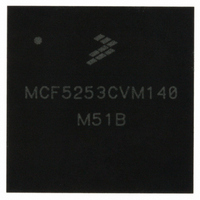MCF5253CVM140 Freescale Semiconductor, MCF5253CVM140 Datasheet - Page 581

MCF5253CVM140
Manufacturer Part Number
MCF5253CVM140
Description
IC MPU 32BIT 140MHZ 225-MAPBGA
Manufacturer
Freescale Semiconductor
Series
MCF525xr
Datasheets
1.MCF5253VM140J.pdf
(34 pages)
2.MCF5253VM140J.pdf
(8 pages)
3.MCF5253VM140J.pdf
(648 pages)
4.MCF5253VM140J.pdf
(2 pages)
Specifications of MCF5253CVM140
Core Processor
Coldfire V2
Core Size
32-Bit
Speed
140MHz
Connectivity
CAN, EBI/EMI, I²C, QSPI, UART/USART, USB OTG
Peripherals
DMA, WDT
Program Memory Type
ROMless
Ram Size
128K x 8
Voltage - Supply (vcc/vdd)
1.08 V ~ 1.32 V
Data Converters
A/D 6x12b
Oscillator Type
External
Operating Temperature
-40°C ~ 85°C
Package / Case
225-MAPBGA
Family Name
MCF5xxx
Device Core
ColdFire V2
Device Core Size
32b
Frequency (max)
140MHz
Instruction Set Architecture
RISC
Supply Voltage 1 (typ)
1.2/3.3V
Operating Supply Voltage (max)
1.32/3.6V
Operating Supply Voltage (min)
1.08/3V
Operating Temp Range
-40C to 85C
Operating Temperature Classification
Industrial
Mounting
Surface Mount
Pin Count
225
Package Type
MA-BGA
Lead Free Status / RoHS Status
Lead free / RoHS Compliant
Number Of I /o
-
Eeprom Size
-
Program Memory Size
-
Lead Free Status / Rohs Status
Compliant
Available stocks
Company
Part Number
Manufacturer
Quantity
Price
Company:
Part Number:
MCF5253CVM140
Manufacturer:
FREESCALE
Quantity:
300
Company:
Part Number:
MCF5253CVM140
Manufacturer:
Freescale Semiconductor
Quantity:
10 000
Part Number:
MCF5253CVM140
Manufacturer:
FREESCALE
Quantity:
20 000
Company:
Part Number:
MCF5253CVM140J
Manufacturer:
Freescale Semiconductor
Quantity:
10 000
- MCF5253VM140J PDF datasheet
- MCF5253VM140J PDF datasheet #2
- MCF5253VM140J PDF datasheet #3
- MCF5253VM140J PDF datasheet #4
- Current page: 581 of 648
- Download datasheet (8Mb)
the endpoint if it is using a queue head. Maximum Length is defined as the minimum of Total Bytes to
Transfer and Maximum Packet Size. The Cerr field is not decremented for a packet babble condition (only
applies to queue heads). A babble condition also exists if IN transaction is in progress at High-speed EOF2
point. This is called a frame babble. A frame babble condition is recorded into the appropriate schedule
data structure. In addition, the host controller must disable the port to which the frame babble is detected.
The USBERRINT bit in the USBSTS register is set and if the USB Error Interrupt Enable bit in the
USBINTR register is set, then a hardware interrupt is signaled to the system at the next interrupt threshold.
The host controller must never start an OUT transaction that babbles across a micro-frame EOF.
24.9.14.1.3 Data Buffer Error
This event indicates that an overrun of incoming data or a underrun of outgoing data has occurred for this
transaction. This would generally be caused by the host controller not being able to access required data
buffers in memory within necessary latency requirements. These conditions are not considered transaction
errors, and do not effect the error count in the queue head. When these errors do occur, the host controller
records the fact the error occurred by setting the Data Buffer Error bit in the queue head, iTD or siTD.
If the data buffer error occurs on a non-isochronous IN, the host controller will not issue a handshake to
the endpoint. This forces the endpoint to resend the same data (and data toggle) in response to the next IN
to the endpoint.
If the data buffer error occurs on an OUT, the host controller must corrupt the end of the packet so that it
cannot be interpreted by the device as a good data packet. Simply truncating the packet is not considered
acceptable. An acceptable implementation option is to 1's complement the CRC bytes and send them.
There are other options suggested in the Transaction Translator section of the USB Specification
Revision 2.0.
Freescale Semiconductor
When a host controller detects a data PID mismatch, it must either: disable
the packet babble checking for the duration of the bus transaction or do
packet babble checking based solely on Maximum Packet Size. The USB
core specification defines the requirements on a data receiver when it
receives a data PID mismatch (for example, expects a DATA0 and gets a
DATA1 or visa-versa). In summary, it must ignore the received data and
respond with an ACK handshake, in order to advance the transmitter's data
sequence.The EHCI interface allows the system software to provide buffers
for a Control, Bulk or Interrupt IN endpoint that are not an even multiple of
the maximum packet size specified by the device. Whenever a device
misses an ACK for an IN endpoint, the host and device are out of
synchronization with respect to the progress of the data transfer. The host
controller may have advanced the transfer to a buffer that is less than
maximum packet size. The device re-sends its maximum packet size data
packet, with the original data PID, in response to the next IN token. In order
to properly manage the bus protocol, the host controller must disable the
packet babble check when it observes the data PID mismatch.
MCF5253 Reference Manual, Rev. 1
NOTE
Universal Serial Bus Interface
24-119
Related parts for MCF5253CVM140
Image
Part Number
Description
Manufacturer
Datasheet
Request
R
Part Number:
Description:
Mcf5253 Coldfire? Microprocessor Data Sheet
Manufacturer:
Freescale Semiconductor, Inc
Datasheet:
Part Number:
Description:
Manufacturer:
Freescale Semiconductor, Inc
Datasheet:
Part Number:
Description:
Manufacturer:
Freescale Semiconductor, Inc
Datasheet:
Part Number:
Description:
Manufacturer:
Freescale Semiconductor, Inc
Datasheet:
Part Number:
Description:
Manufacturer:
Freescale Semiconductor, Inc
Datasheet:
Part Number:
Description:
Manufacturer:
Freescale Semiconductor, Inc
Datasheet:
Part Number:
Description:
Manufacturer:
Freescale Semiconductor, Inc
Datasheet:
Part Number:
Description:
Manufacturer:
Freescale Semiconductor, Inc
Datasheet:
Part Number:
Description:
Manufacturer:
Freescale Semiconductor, Inc
Datasheet:
Part Number:
Description:
Manufacturer:
Freescale Semiconductor, Inc
Datasheet:
Part Number:
Description:
Manufacturer:
Freescale Semiconductor, Inc
Datasheet:
Part Number:
Description:
Manufacturer:
Freescale Semiconductor, Inc
Datasheet:
Part Number:
Description:
Manufacturer:
Freescale Semiconductor, Inc
Datasheet:
Part Number:
Description:
Manufacturer:
Freescale Semiconductor, Inc
Datasheet:
Part Number:
Description:
Manufacturer:
Freescale Semiconductor, Inc
Datasheet:











